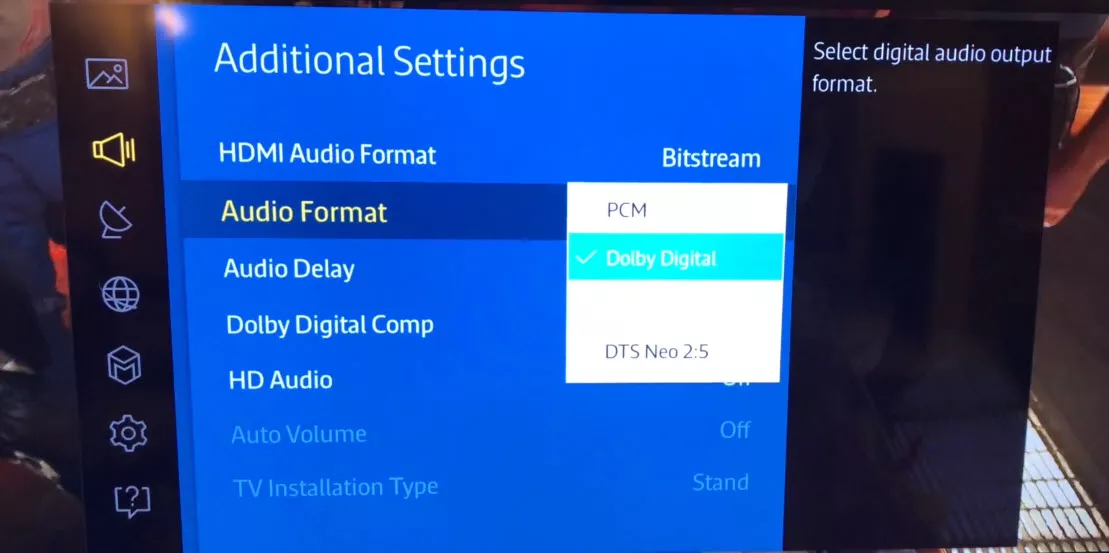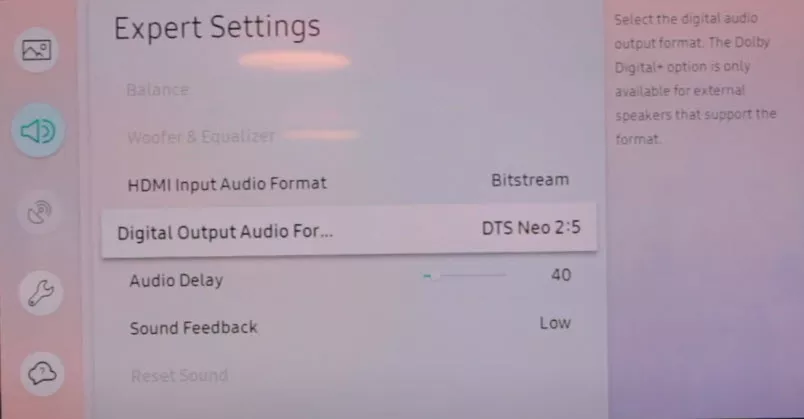What Is DTS NEO 2.5?
The technology of DTS Neo 2.5 (5) is based on the proven DTS Neo algorithm (4) and generates a three-dimensional sound experience (1). Since human hearing rates sound signals in the front area more strongly than those that come from behind (2), the DTS-Neo algorithm adds two front loudspeakers (6) to give the sound more spaciousness (3). So, what is DTS Neo 2.5?
DTS NEO 2.5 is a multi-channel surround virtualization audio format proprietary from Samsung and DTS, that takes a stereophonic 2.0 audio stream and transforms it into surround sound through the execution of an algorithm.
It is found in Samsung devices due to their business partnership with DTS.
DTS Neo 2.5 is an audio format with the same channel division as with Dolby Digital, mostly 5.1. DTS works with a constant bitrate of 64 to 1536 kbit /s, on the DVD with 384 or 448 kbit /s, the sampling rate goes from 48 to 192 kHz at up to 24 bits. With the DVD there is compression, lossy, with a factor of 4. With many DVD players, you can see a DTS symbol on the front panel, but these DVD players do not have a DTS decoder at all.
If you look closely, the text “Digital Out” appears under the DTS. This means that you have to use a receiver/amplifier with a DTS decoder to enjoy DTS format. The subwoofer channel goes from 20 to 80 Hertz. This format has existed since May 1993.
The surround sound is created through the algorithm, but it is not a real surround, that’s the difference. Probably the problem is due to the fact that you use an optical connection, usually, the optical connection has problems transferring multi-channel streams (e.g. it does not transfer the DTS HD and master audio streams) and in any case, it should not be used, you must use HDMI to the TV-AVR connection.
In order to take advantage of the DTS Neo, the user is advised to remove the optical cable Toslink (proprietary standard from Toshiba) and put an HDMI in its place.
Some users reported that they have to turn up the volume further than under Dolby Digital.
DTS Neo is, therefore, another multichannel audio format from DTS, direct competition from Dolby. It consists of exactly the same channels: 6, with two front left and right speakers plus another center speaker, two rear left and right speakers, and the LFE channel. The first film to adopt this format was Jurassic Park, in 1993.
DTS is obtained from an original PCM source at 48 Khz and up to 20 bits, and although it also compresses data, the compression is less, freeing files with a bit rate generally between 768kbps and its maximum of 1536kbps.

Dolby Digital Vs DTS Neo 2.5
The difference between Dolby Digital and DTS NEO 2.5 is in the compression rate. While Dolby Digital´s compression rate is higher, DTS has a lower compression. Therefore, DTS NEO 2.5 has more fidelity to the original source and a higher bitrate.
DTS NEO 2.5 achieves mathematically better empirical results versus Dolby Digital in waveform analysis with higher bitrate dimensions, resulting in an analytically superior attribution of fidelity.
Furthermore, for humanly relevant audible differences, adequate testing approaches are the double-blind test, MUSHRA testing, or ABX. Adult humans in standard conditions have difficulties to distinguish rates between 128 kbit /s and 192 kbit.
Empirical tests such as waveform analysis will most definitely show differences in the output, but that doesn’t mean the differences are audible for us in normal conditions.
DTS has a higher bitrate and sounds technically better. But as users do not hear the difference between 128 kbit / s and 192 kbit, they would be the same in practice.
The output in DTS NEO 2.5 is available in Samsung devices and was developed on a partnership between Samsung and DTS. It occupies more storage space than the same object in Dolby Digital as it compresses less.
Finally, we can say that the original mixing of the soundtrack will establish the most important difference in the quality of the sound, with disregard of the audio format selected afterwards for the audition.
For human audition in standard conditions, there is practically no difference between these systems. With the Devialet Gold or Silver, it is possible to distinguish differences between output in laboratory testing conditions that normally are not related to typical user requirements of these products.
Setting PCM or Bitstream settings does not influence the decision Dolby Digital Vs DTS Neo 2.5, because PCM and Bitstream are related to the HDMI input audio format.

Since the DVD only has a limited storage capacity (single- layer 4.7 GB), the developers of DTS and Dolby had to use mathematical tricks to compress the soundtrack from the amount of data. The audio tracks on the new Blu-Rays are uncompressed due to the large storage capacity of the disc. In terms of size, the difference between DTS and Dolby Digital is that DTS grants the sound larger amounts of data and is, at least in theory, a little bit better in quality than Dolby Digital. This can also be demonstrated in many hearing tests (provided the system is good).
The decision between stereo and 5.1 is more important: If you have the option to choose between Dolby Digital and DTS, often only one soundtrack is recorded in 5.1 surrounds, the other in stereo or in the old Dolby Surround method. Then be sure to choose the 5.1 variant. Whether it comes from Dolby or from DTS is less important here. You can make these settings in the audio setup of the inserted DVD.
Connecting To The AV Receiver
Connect the DVD player to the AV receiver using a digital cable. This can be done either via the audio-out connection or the Toslink (Toshiba Link cable format) connection.
In any case, AV receivers always have options for using one of the two variants. However, there are some small differences in sound.
If you have wired everything you need (often called by pressing the “Setup” on the remote) set the digital output to Dolby Digital or DTS before the first start yet in the setup of the DVD player.
Conclusions
DTS is said to sound better. It inherently uses a higher data rate, which could support this statement. Conversely, it is also claimed that DTS soundtracks are simply louder and mixed with more bass. If you take a closer look at the topic, it quickly becomes clear that the mixing of the soundtrack in origin is a much more important factor for the sound quality: and that can be good or bad for both Dolby and DTS.
Further Readings
We have some other interesting articles for you to read, we have selected our top articles below, and tried to keep this list short.
We have a technical vademecum where we discuss industry terminology and how it can be useful for you. Selected examples are the definition of PCM audio, then comes the comparison between PCM and Bitstream, the comparison between DTS Neo 2.5 and Dolby Digital, and the process to match amplifiers to speakers.
Also, we have reviewed some interesting DAC: The Elgar Plus from dCS, and the Schiit stack. where the Modi 3 behaves as an entry-level DAC.
In our reviews of AV receivers, we can recommend you to read some of our favorites, the ones that we liked the most, and trying to make the list short, we have the Denon AVR-X2500H, the Onkyo TX-NR686. We also have reviewed completely the Denon 8K receivers where we have studied the 8K Denon AVR-X2700H, the Denon AVC-X6700H, the AVC-X4700H, and the AVC-X3700H.
If you are into amplifiers, my favorite is the McIntosh MA9000, and that is why I would like to recommend you to read that review. My second favorite amplifier is the Mark Levinson 5805.
Regarding speakers, we have reviewed tiny bookshelf-speaker devices to large towers. My favorites were: the Devialet Gold, the Devialet Silver, the ProAc Response DT8, the Bowers and Wilkins 805 D3,
We do not review many headphones, but if you want a Sennheiser headphone for less than 100 dollars, we have this Sennheiser HD595 review.
We have some TV and monitor reviews and here we recommend the Samsung NU8000 (for gamers!) and my favorite is the review of the classical Pioneer Kuro.
Our home theater aficionados want to know everything about video definitions and configurations. So we studied 720p, how to scale it to 1080p the right way, and compared 1080p with 1440p and demonstrated why 1440p is not always better. Likewise, we had the urge to compare 1440k with 4K and try to find out how much are we gaining with the change.

I am Bob. I work as an audio engineer and audio technician. I work in mastering and arranging bridges in existing songs and the arrangement and orchestration of the chorus. In Planet HiFi I test gear for a couple of days and write a review. I also write about AV topics, amplifiers, speakers, and headphones.

